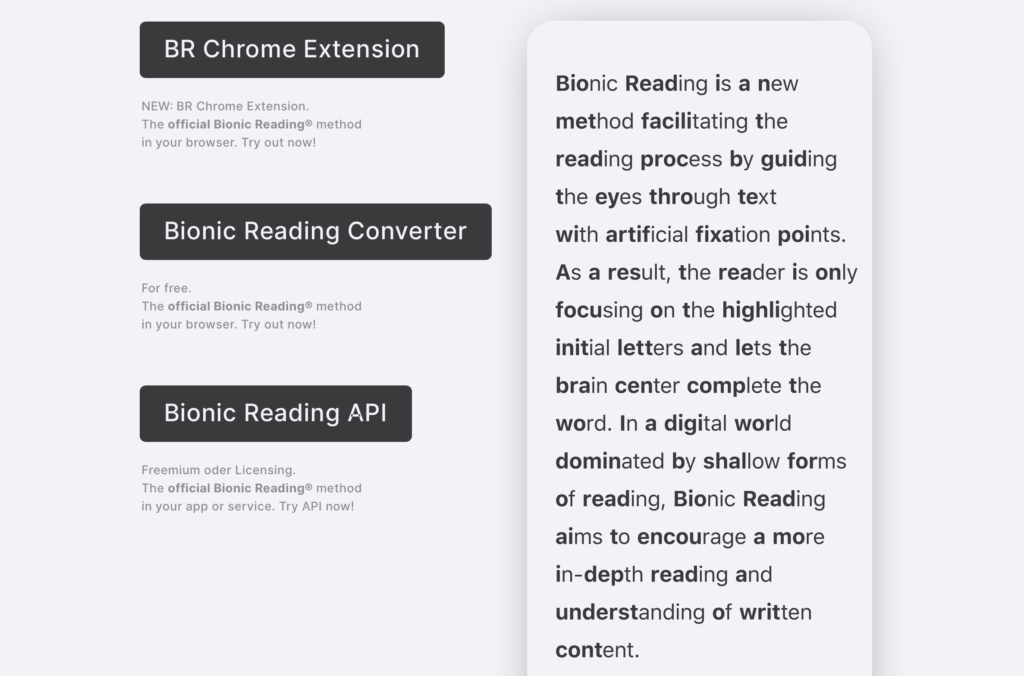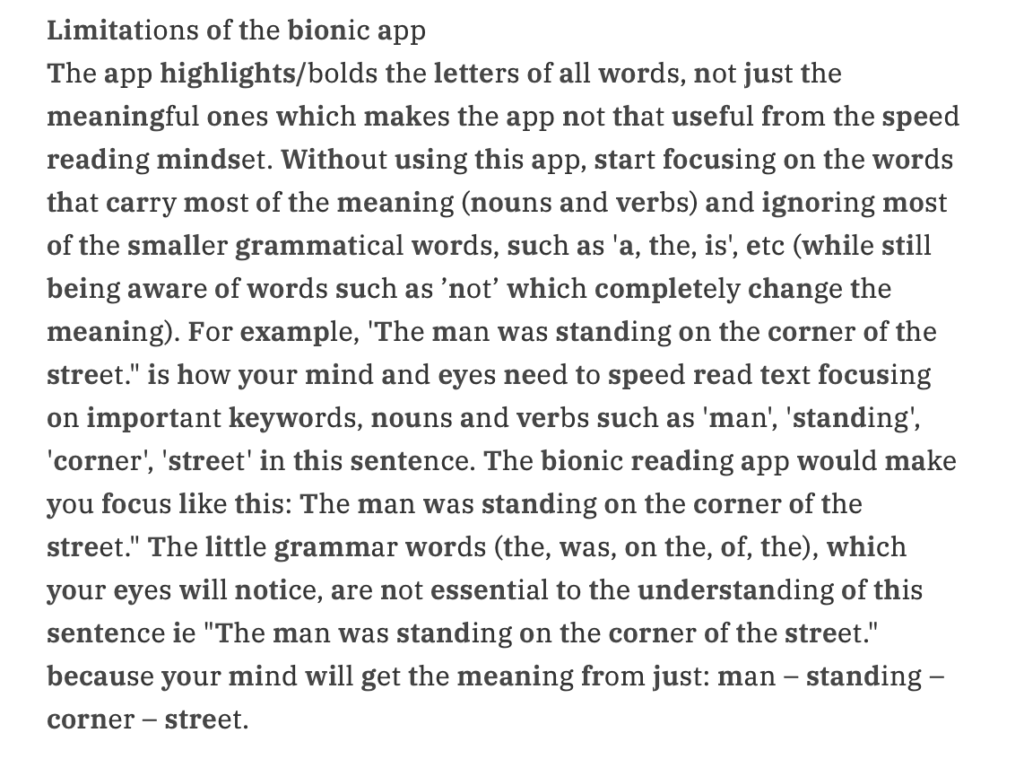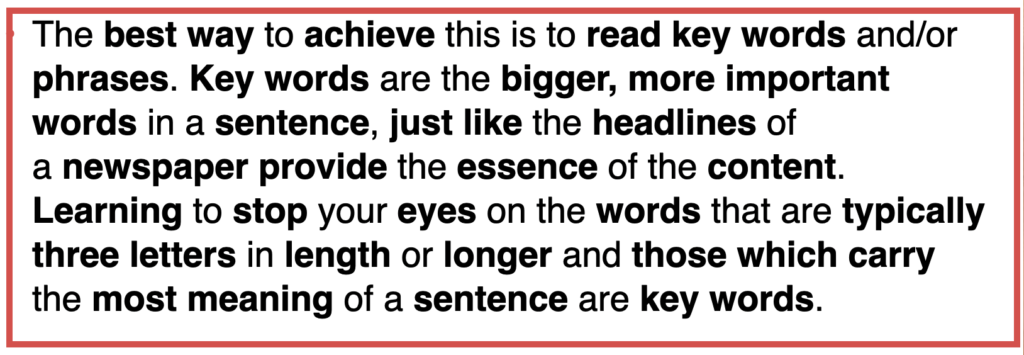Does the bionic reading app really help with reading?
Is there an effective speed reading app out there?
We have not yet found an app that we can recommend to help speed up reading. The most important thing is getting what you need from a text – and understanding it. The apps we’ve found so far are mechanistic and work with
words rather than
meaning and
comprehension. We’ve discussed speed reading apps before and
fonts that might help you read faster. Hopefully, in the future, AI will be able to analyse text and help you focus on meaningful keywords and keyphrases that could potentially help with faster and more effective reading, with increased comprehension.

Bionic reading app
Does the bionic reading app work?
Our recent find app for reading Bionic Reading (developed by Swiss typographic designer Renato Casutt) helps you focus on the beginnings of words with the aim of speeding up you’re reading. It’s true that as soon as you’ve understood the word you can move on quickly. With novels, for example, I usually recognise the characters by the first letter of their name, so it’s really annoying when two names start with the same letter, or worse when two characters have the same name (although that happens more in real life than in fiction). But as soon as you’ve understood where a phrase or sentence is going, move on. More importantly, when you’ve understood where a paragraph or page is heading, move on too.
If you really don’t know how to focus on the first letters of a word, then sign up for the free trial of this app or try
the bionic reading text convertor. The app has some limited settings that allow for some options such as increasing and decreasing the number of the first letters, fonts and layout settings. The option to decrease the number of bolded letters is useful because you can eliminate less necessary grammar words such as ‘a’. And as soon as you’ve got the benefit of that skill, move on to many other small skills which can help you.
Research on the bionic reading app
According to a
Guardian article, “Casutt says he has overseen a study involving 12 readers who were asked to read a text in bionic and ordinary text like what you’re reading now. Casutt concedes that the results from his tests are not clear but claims most subjects reported that bionic had a positive effect on reading (whereas a minority reported feeling “disturbed”).
Limitations of the bionic reading app
The app highlights/bolds the letters of all words, not just the meaningful ones which makes the app not that useful from the speed reading mindset. Without using this app, start focusing on the words that carry most of the meaning (nouns and verbs) and ignoring most of the smaller grammatical words, such as ‘a, the, is’, etc (while still being aware of words such as ’not’ which completely change the meaning).
For example, “The man was standing on the corner of the street.” is how your mind and eyes need to speed read text focusing on important keywords, nouns and verbs such as ‘man’, ‘standing’, ‘corner’, ‘street’ in this sentence. The bionic reading app would make you focus like this: The man was standing on the corner of the street.” The little grammar words (the, was, on the, of, the), which your eyes will notice, are not essential to the understanding of this sentence ie “The man was standing on the corner of the street.” because your mind will get the meaning from just: man – standing – corner – street.

An example how the bionic reading app would try to help you read faster by highlighting the first letters of the paragraph above
Another example, which text is easier to read?
Bionic reading?
Cn yu red t is? WEIRD: How cmoe yuor bairn is albe to undnertsnad tihs snetence eevn tghouh only the frist and Isat Itetres of ecah wrod are crreoct? It deosn‘t mttaer in waht oredr the Itteers in a wrod are, the olny iprmoetnt thing is taht the frist and Isat Itteer be at the right pclae. The rset can be a total mses and you can sitll raed it wouthit porbelm. Tihs is bcuseae the huamn mid deos not raed ervey lteter by istlef, but the wrod as a wlohe. And you touhhgt taht sepllnig was iprmoetnt!
Or regular reading?
Cn yu red t is? WEIRD: How cmoe yuor bairn is albe to undnertsnad tihs snetence eevn tghouh only the frist and Isat Itetres of ecah wrod are crreoct? It deosn’t mttaer in waht oredr the Itteers in a wrod are, the olny iprmoetnt thing is taht the frist and Isat Itteer be at the right pclae. The rset can be a total mses and you can sitll raed it wouthit porbelm. Tihs is bcuseae the huamn mid deos not raed ervey lteter by istlef, but the wrod as a wlohe. And you touhhgt taht sepllnig was iprmoetnt!
Focus on ‘hot spots’ of key information
In our
Speed Reading Bible we cover this in speed reading technique number 11:
Focus on ‘hot spots’ of key information. And if you’re still at the stage where you’re being slowed down by saying all the words to yourself as you read, then speed up by ‘saying’ only the keywords which give the meaning. You’ll read faster, and you’re working towards better note-taking. Actually, both those additional speed reading tips are better than focusing on the first letters of words.

Speed read by focusing on keywords and keyphrases



